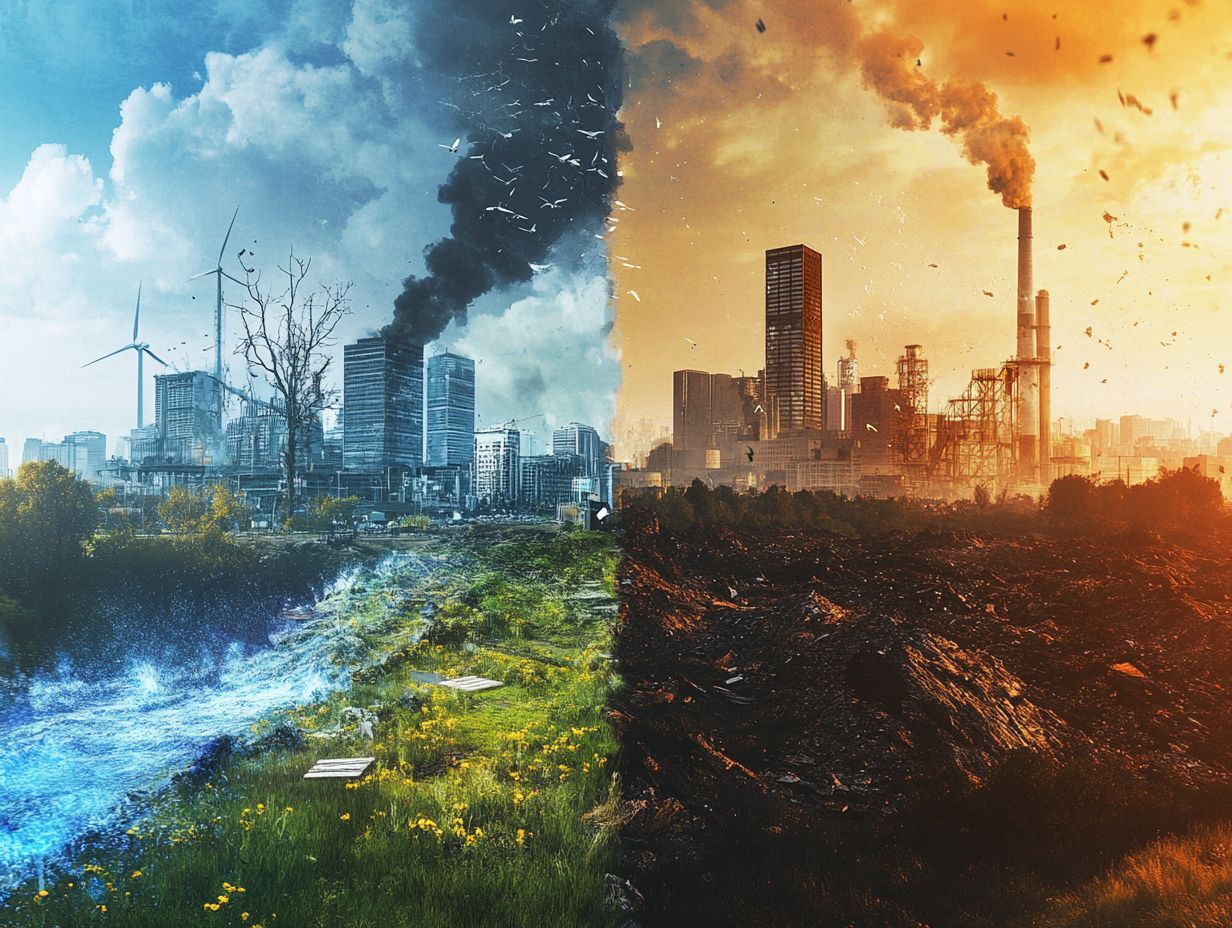Defining Doomsday

Doomsday refers to a catastrophic event that could bring an end to civilization as we know it, encompassing existential threats such as climate change, nuclear weapons, and technological disruptions that may lead to widespread chaos and destruction.
This topic is significant in the field of policy-making because understanding and preparing for these existential threats is essential for resilience and adaptation in our increasingly complex world.
Historically, doomsday has been closely associated with religious and mythological narratives, often depicted as an apocalyptic end of the world or a final judgment. In modern times, the definitions have expanded to include scientific perspectives on the potential threats to global civilization.
Major contributors to potential doomsday scenarios include human-induced environmental degradation, such as rising sea levels and extreme weather events, as well as rapidly evolving technologies that, if mismanaged, could result in unforeseen consequences, such as artificial intelligence malfunctioning.
It is crucial for societies to unite and innovate as we address these pressing issues, as the risk of doomsday looms ever closer.
The Impact of Technology
The impact of technology on society is profound, influencing every aspect of our lives, from automation and artificial intelligence to cybersecurity and the digital economy. This influence presents both opportunities and challenges, especially in the context of doomsday prevention and acceleration.
As we navigate rapid technological advancements, it is essential to evaluate how these innovations can be harnessed to enhance disaster preparedness and mitigate risks associated with existential threats. For instance, advanced monitoring systems and predictive algorithms can enable societies to predict and respond to natural disasters more effectively, potentially saving countless lives.
However, these same technologies can also lead to the proliferation of autonomous weapons and cyber warfare, raising significant ethical concerns. Furthermore, the relentless pace of technological disruption can leave communities vulnerable, widening the gap between those who can adapt to rapid change and those who cannot.
By fostering discussions around responsible innovation and ethical governance, society can strive to ensure that technology remains a force for good while remaining mindful of its darker potentials.
Positive Effects of Technology on Doomsday Prevention

The positive impact of technology on doomsday prevention is evident across various sectors, including renewable energy and data analysis. These advancements significantly enhance our capacity to improve disaster preparedness and public health, resulting in a more resilient society.
Advancements in Disaster Preparedness
Technology plays a crucial role in enhancing disaster preparedness through the development of risk assessment tools and predictive analytics that help anticipate and mitigate the impacts of potential hazards on communities. These advancements enable governments and organizations to implement well-planned strategies that foster community involvement and strengthen response activities to both natural and human-made disasters.
For instance, systems that utilize machine learning algorithms can analyze historical data alongside real-time information to identify trends related to disasters, indicating when evacuations or resource distribution should occur. Geographic Information Systems (GIS) allow for detailed mapping of areas of concern, facilitating informed intervention strategies.
In the case of Hurricane Harvey, cities utilized such technologies to assess damage and coordinate relief efforts effectively. As technology continues to evolve, it is essential for communities to learn best practices for leveraging these tools to remain prepared for the unforeseen.
Improvements in Communication and Coordination

Improvements in communication and coordination through technology are essential for effective disaster response, as they enable real-time information sharing and collaboration among emergency response teams and humanitarian stakeholders, including public health agencies.
The rise of social media platforms has transformed the way communities communicate during disasters, facilitating the rapid dissemination of critical information and enhancing coordination efforts. These platforms give the power to citizens to quickly report incidents, share updates, and mobilize resources, thus serving as valuable partners in emergency management.
Additionally, mobile applications not only provide alerts but also function as important data collection tools, offering insights from the community that can inform decision-making. As communities increasingly adopt these technologies, the positive implications for public health become evident.
Negative Effects of Technology on Doomsday Acceleration
While technology offers numerous benefits, it also presents significant downsides that can exacerbate doomsday scenarios. This is particularly evident in areas such as environmental destruction and the potential weaponization of advancements in technology, including artificial intelligence and cybersecurity.
Furthermore, the widespread dissemination and accessibility of misinformation through digital channels amplify these technology-related risks, making it increasingly difficult to address critical existential threats like climate change and natural disasters.
Environmental Impact of Technological Advancements

The environmental impact of technological advancements is a significant concern, as innovations often contribute to climate change, resource depletion, and biodiversity loss, potentially exacerbating doomsday scenarios.
To address these issues effectively, sustainable practices that minimize negative outcomes and enhance environmental protection are essential. A prominent example is industrialization, which has increased productivity but has also resulted in carbon emissions and waste.
Additionally, the rapid expansion of digital technology can lead to higher energy consumption and e-waste, placing further stress on fragile ecosystems. Implementing renewable energy sources, improving recycling systems, and obtaining green certifications can help individuals and organizations mitigate these adverse effects.
Ultimately, sustainable design and innovation are crucial to ensuring that the relationship between technology and the environment remains positive in the future.
Potential for Weaponization of Technology
The potential for weaponization of technology, particularly in automation and artificial intelligence, has intensified concerns about geopolitical tensions and the future of global security, including the use of nuclear weapons. As nations invest in advanced technologies, the risk of misuse or escalation into conflict grows, underscoring the urgent need for discussions on regulation and responsibility.
This issue is further complicated by the rapid pace of innovation, where new capabilities are developed faster than effective governance structures can be established. As various countries apply these technologies for military purposes, the likelihood of misunderstandings and miscalculations increases, heightening the risk of unintended conflict.
Therefore, establishing robust regulatory frameworks is essential to ensure that ethical considerations are integrated into the development of new technologies. Without collective efforts to foster dialogue and accountability, the already complex web of global relations could face irreparable damage.
Balancing the Role of Technology in Doomsday Prevention
The role of technology in preventing doomsday scenarios must be carefully balanced, ensuring that the benefits of technological advancements outweigh their potential dangers.
This balance is achieved through thoughtful ethical considerations and regulation of technology usage. By doing so, innovation can be effectively harnessed to support strategies for preparing for and preventing doomsday scenarios.
Ethical Considerations
Ethical considerations surrounding technology are of utmost importance, particularly concerning their effects on public awareness, bioethics, and data privacy, which can significantly influence societal reactions to doomsday scenarios. It is essential to address these ethical considerations to foster trust and ensure that technological development benefits society as a whole while minimizing harm.
Society’s apprehensions about the potential consequences of biotechnology and data-driven technologies highlight the need to evaluate how these innovations intersect with moral obligations. Encouraging public knowledge and dialogue about the ethical application of technology can help individuals critically assess and understand the implications of surveillance technologies and genetic engineering.
Effective policies that prioritize transparency and accountability are crucial for ensuring the ethical development and use of technologies aimed at preventing doomsday situations. Promoting responsible behavior and an environment of open engagement is necessary to strive for a future where technology serves not only as a tool but also as a means of fostering positive change in society.
Regulation and Responsibility
Proper regulation and accountability are crucial for ensuring that technology is used for doomsday prevention while minimizing the risks associated with its destructive misuse. Frameworks designed to hold stakeholders accountable can enhance disaster preparedness and foster responsible innovation in the face of existential threats.
These accountability frameworks must include not only governments but also private industry, researchers, and civil society, all of whom play a role in shaping the ethical standards of technological development. A strong example of effective regulation is the European Union’s General Data Protection Regulation (GDPR), which both enforces data privacy and security and give the power tos individuals.
Additionally, international agreements on artificial intelligence and genetic engineering highlight the importance of collective approaches to emerging risks. By prioritizing ethics and safety collaboratively, these stakeholders can mitigate dangers, ensuring that technological advancement enriches humanity’s existence rather than endangering it.


